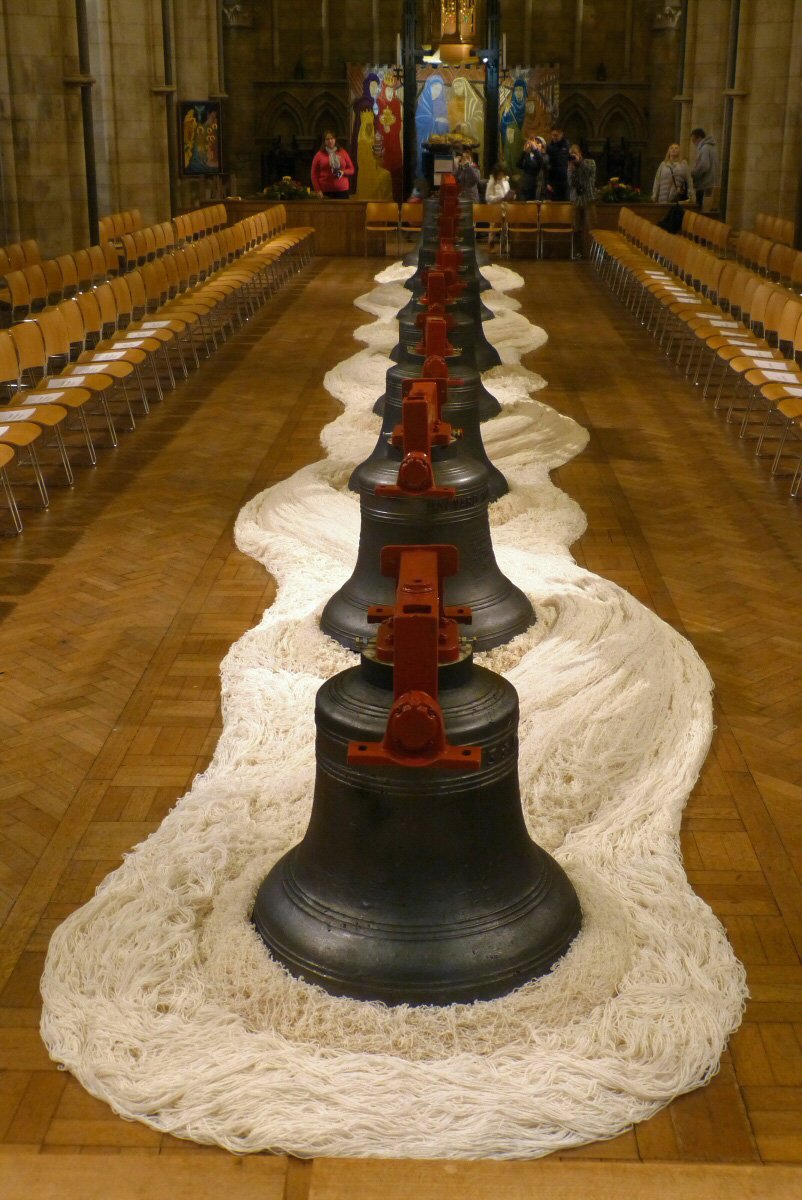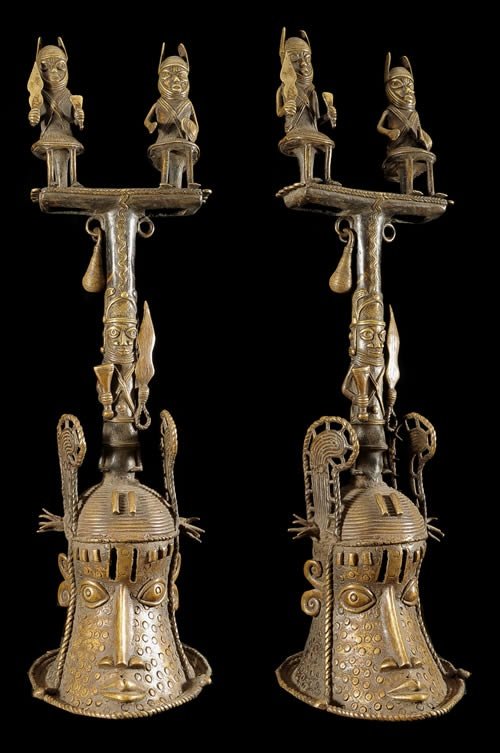
Ringing in 2022 - Bellcraft
by Victoria Thomas
This time of year, we hear the merry jingle of Santa’s sleigh-bells everywhere we go. The sound is relentlessly cheery, pealing through open-air Christmas fairs, supermarkets, offices, bars and even hospital waiting-rooms as here we come a-wassailing, among the leaves so green. And the 1946 Frank Capra holiday classic reminds us, “Every time a bell rings, an angel gets its wings.” But the ringing of bells is more than just a frivolous holiday trifle. The use of bells predates Christmas, and Santa, by several thousand years, and bellcraft represents an unusual meeting of secular and sacred that persists in our unconscious, far beyond the reach of known memory.
Let’s start with the reindeer in the room, Santa’s flying steeds. Keepers of livestock from Turkey to Taos tie bells to their animals. In purely practical terms, bells tied around the necks of horses, bulls, cows, sheep and goats are an early warning system, alerting pedestrians to stand clear.
It might even be argued that bells scare off common predators, like coyotes. But ancient glyphs and tapestries show bells as part of the armor worn by chargers into battle, revealing a slightly more intriguing belief: that ringing bells banish enemies. Along the same lines, this is also why bells are traditionally hung over shop doors in the Mediterranean, in many parts of Asia, and just about everywhere else. Yes, the jingle alerts the shopkeeper to the entrance of a customer…and also keeps bad juju from entering your place of business.
For centuries, bells have served in very ordinary circumstances, to announce each passing hour, or to send a warning. In some small Mexican towns, a local official walks the cobblestone streets ringing a hand bell each week, reminding residents to set their trash outside their doors. Because the day may vary, the bell is helpful.
But bells are most deeply associated with matters of the spirit. The skill and risk required to cast and raise a great bell in the centuries past is nearly impossible for us to fathom. It was, like the building of Stonehenge, a seemingly superhuman accomplishment.
Great bells impart a sense of powerful mystery, because we know that their mere coming into being and existence is something of a miracle—a feeling which our ancestors surely must have had before the perfection of the internal combustion engine, modern motor, and power tools to do the heavy lifting.
In the sprawling Soviet epic historical drama, “Andrei Rublev” directed by Andrei Tarkovsky in 1966, the creation of a massive church-bell in medieval Russia serves as a haunting metaphor of self-realization. Famine and the Black Death are ravaging the 15th-century empire, and in desperation the Grand Prince of Vladimir sends his envoys to a remote village to find the master bell-maker who lives there. The mission: to purge the land of the demons causing the Plague by casting a new bell for the church.
Arriving in the village, the officers find everyone dead but Boriska, a young boy whose father was a bellsmith. Boriska convinces the envoys that his father passed on the secret of bellfounding to him before he died, and persuades them to take him to the city to create the bell for the Grand Prince.
This is literally a “brazen” – meaning brassy, like the bell itself – lie. Boriska is an arrogant fraud who tells the dangerous lie to escape his doomed village. No deathbed secret was shared, and the boy operates on instinct alone, in spite of constant discouragement from the work-crew and ignoring the threat from the Prince that he will behead the bellsmith if the bell fails to ring. In the film’s final moments, Boriska crumples to the ground after the bell is pulled from the earth, emblazoned with Russian Christendom’s most favored ikon, St. George the dragon-slayer. Triumphantly, impossibly, the bell is raised and rung, and the crowd rejoices. We witness suffering purified into sublime bliss. As the camera pans over the dying coals that smolder at the feet of the sobbing boy, we understand that he, too, has passed through the fire, destroyed, violently transformed, and made new.
Christian practice tolls the bells to announce grand life-passages, and to keep the faithful in a state of grace. Consider the widely-reproduced oil painting called “The Angelus” (1857-1859) by Jean-Francois Millet, where a farming couple pauses in their labor to pray. This particular painting, a commission that was never claimed, is accompanied by a haunting legacy. Originally entitled “Prayer for the Potato Crop”, the initial version contained an element now concealed: a tiny coffin laid at the feet of the praying couple. Millet eventually painted over the child’s coffin, replaced it with a basket of potatoes, and added a distant church steeple to the skyline, shifting the apparent visual story from heartstruck grief to one of obedient piety and perhaps acceptance. Peals from that bell-tower cross the barren twilight fields, perhaps to offer solace for the hidden loss endured by the subjects. Why did the patron who commissioned the painting never return to claim it? Was the grief simply too much to bear, without the cleansing church chime from the far-off village square?
Knowing this about Millet’s painting supports Immanuel Kant’s definition of the sublime, which he described as a kind of “agitation”, even a sense of displeasure that we experience in its presence. Kant wrote that the sublime makes the soul feel shaken, as opposed to the calm feeling engendered by a work of mere beauty, and this is the case when viewing “The Angelus” even without knowledge of its provenance.
The use of bells in Christendom echoes with the unmistakable resonance of a pagan past, when Germanic and Nordic cultures rang in the winter solstice (dangerously close to the current date for Christmas) to drive off unclean spirits and invite the sun’s return. Traces of a world lit only by fire persist across traditional Roman Catholic rite concerning the blessing and consecration of bells.
Whether installing a new bell, or reintroducing a bell after repair or restoration, a Bishop or priest and an acolyte anoint the bell with Holy Oil, thymiama (ground myrrh, resin, and incense), and Holy Water. Circling the bell from north to south, west to east, the Holy Oil is used to mark seven crosses along the lip of the bell, dedicating its voice to the Archangel Raphael for the of healing the sick.
The interior of the bell is blessed with the smoke of burning thymiama as the Bishop or priest intones, “In the Name of the Most High God, I exorcise all evil and dark influence from this bell. May they be forever banished and driven from this bell which we are about to dedicate to His service.” Words to this effect were often inscribed on the great bells of medieval churches, warding off demons with every chime. The bell’s ropes are blessed separately. For centuries, quadrants of small sanctus hand-bells, suspended from a bronze frame, were rung during Mass as the sacraments were presented, signaling the miracle of transubstantiation.
In centuries past, the sounding of a church bell was believed to serve as a delivery-system for transmitting prayer to the Almighty. The same powers were ascribed to the rising wafts of incense, as well as the supernaturally charged and holy light which passed through the stained-glass windows of a church. Not surprisingly, this attitude toward bells and the bells themselves were both effectively silenced throughout much of the Reformation, and these practices are in decline even among observant Catholic and Anglican congregations today.
History notes that uncounted numbers of the great bells of medieval Europe were melted down to make cannons and other weapons in more recent times. Between 1939 and 1945, 175,000 bells across Europe, many of them centuries old, were seized by Nazi Germany and transported to collection-points in Hamburg and other towns known as Glockenfriedhöfe, or bell-cemeteries. Most were made into shell casings. The collaborationist Vichy government of France negotiated with the Nazis to save the church-bells of France, offering up priceless bronze statues in their place—although bombing raids nonetheless reduced “Jeanne d’Arc”, the largest bell in France at 20 tons, to a pile of ashes.
And yet, we return to bells when seeking our place in the cosmos. We find a stunning meditation on the life of bells in the installation art of Angela Wright, a British artist who makes large-scale works in Churches, galleries and public spaces in her native UK and beyond.
Among Wright’s ongoing work is the creation of installations at Southwark Cathedral, located on the south bank of the Thames in London. The site has been a place of Christian worship for more than 1,000 years, and Southwark in its present form dates from between 1220 and 1420 CE, making it the first Gothic church in London. In 2016 -2017, Wright participated in “The 12 Bells Project”, the year-long refurbishment of the Cathedral’s mighty bells.
The church that is now Southwark Cathedral was founded as an Augustinian Priory in 1106 CE. Construction of the tower with its seven original bells began in 1310 CE. William Shakespeare paid for those bells to be rung at the funeral of his younger brother Edmund in 1607, and in 1869, Charles Dickens attended ringing practice of an upgraded set of twelve bells there—a mere glimpse into the history of a place and its bells which remain deeply rooted in the English soul. Great Britain has long been called “the Ringing Isle” for its many church-bells.
Images kindly furnished by the artist, Angela Wright.
Discussing “The 12 Bells Project”, the Very Reverend Andrew Nunn, Dean of Southwark, commented “Every hundred years or so, the bells need some attention. They basically need a good clean, but they also need turning, so that the strike happens at a different point on the bell.”
Soolip recently corresponded with Wright via email about her role in the project, where she used wool as her medium. She wrote, “When the Dean invited me to make a celebratory installation for the re-dedication of the bells, I was very aware that it would be a rare and special moment to experience the bells on the floor of the nave. They were sent to the foundry in July 2016 and were returned to the Cathedral in 2017. In those months, a silence had fallen over the surrounding area. Even the clock had stopped.” This silence is most significant in context, since within the traditional church calendar, the only time that church-bells do not toll are the grave hours connoting the Passion of Christ, ending with jubilant chiming on Easter morning to signify the Resurrection.
Images kindly furnished by the artist, Angela Wright.
Wright explains that she took inspiration from the nearby Thames to create a flowing river of woolen strands that cradled the extraordinary procession. She says, “The softness, complexity and changing rhythm of the ‘flowing’ wool contrasted with the dark colours of the metal bells which, however massive, seemed to float. The bells and wool engaged with each other down the distance of the aisle. On the day that the bells were re-hung, someone from the foundry took a handful of the wool up to the belfry for someone else to find in years to come.”
Wright’s eloquent choice of wool speaks to a cellular understanding of her island home. Drizzle, fog, rain, and the sea-washed green fields dotted with white sheep are all deeply embedded the Celtic psyche. For Christians, the material reference to the Lamb of God elevates wool from the earthy and literal into the sacrificial, mystical, and sublime.
And yet, in spite of their antiquity, the bells of Europe are relative newcomers in the history of bellcraft which finds its origin point in Asia long before the advent of Christianity. Fantastically crafted bells appeared in China near the beginning of the Bronze Age around 1,700 BCE, when skilled artisans there first perfected the alloy of copper and tin which is harder and more durable than either of the source-metals alone. It wasn’t until the second century CE that cast iron bells, the predecessors of those at Southwark, overtook bronze in popularity.
China’s dominance as the seat of Bronze Age technology is perfectly expressed in the burial suite of Marquis Yi of the state of Zeng. The Marquis was interred near the end of the Chinese Bronze Age in the year 433 BCE. Among the treasures laid to rest with him: an enormous set of 65 bronze bells called bianzhong, arranged into a single musical instrument that likely required five people to play.
Chinese bronze artisans pushed the envelope of the emerging technology of metallurgy in the Western Zhou period from 1050 to 771 BCE. In this period, experimental and eccentric shapes emerged as the artisans learned to produce two different tones in the same bell by casting them in oval, rather than circular, forms. The 65 bells found in the Marquis Yi of Zeng’s tomb are identified by specific tones, an accomplishment requiring precise control of the ratios of copper, tin and other additives including zinc and lead, as well as the molds used to cast them. Markings specifying a musical note are cast into each bell, not etched into the metal afterward, demonstrating the artisan’s absolute confidence in technical accuracy. This is most remarkable when you consider that bronze begins to melt at an infernal 1,700º F, a temperature which the first Chinese artisans produced by burning coal, and possibly even wood.
Unlike most other musical instruments, bells are fixed pitch, meaning that their sound typically does not change unless the metal is drastically altered. Thus, a bell made 2,500 years ago will likely sound just as it did when it was new. Somehow this integrity of substance communicates itself to us, even if we don’t consciously recognize this as fact. When we hear a bell, especially an old one, we may sense an ancestral voice speaking to us across time. In the western world at Christmas-time, at weddings, at funerals, and even on an occasion as ordinary as telling the hour , this sound fills many of us with an inexplicable longing.
In ancient China, bells like those we call windchimes today were used as a hybrid fortune-telling, weather-predicting tool. Hung from stalks of bamboo, the arrival of a strong wind was generally received as news of a coming epidemic or other disaster. The unique modern bells of Cosanti, hand-made in Arizona of ceramic or bronze, are an artfully rough-hewn, contemporary expression of that ancient lineage. Made in an array of sizes and shapes, these highly collectible bells find their voice by virtue of the artisan community’s distinct, signature cruciform clapper.
Zen practitioners in the tradition of Thich Nhat Hanh today liken the “inviting” of a bell with a wooden mallet – many prefer not to use the violent-sounding term, “striking” – to their own breathing and heartbeat. In this context, the bell, which some call a singing bowl, may be a standing bell with no clapper, seated on a floor-cushion. Hanging bells and hand-bells are also revered in Buddhism. A seated bell must be handled with two hands, not “off-handed” with just one, as a sign of respect. The bell is invited to awaken by a short, light tap, followed by stronger taps that send out deepening, widening vibrations of sound.
Many older, larger bells find their place in the narrative of Asian bellcraft, including the Todai-ji Temple Bell in Nara, Japan cast in the year 732 CE by an unknown foundry. The voices of these bells serve many roles throughout the breadth of Buddhist practice. A bell may be used to clear a meditation space, and as a device to keep a practitioner’s focus on the present. Tingsha bells, often incorporating a vajra or lightning-bolt motif, have been used for centuries in Tibet to awaken awareness and stimulate the healing process, and are sounded to begin and close a meditation session. In some forms of Buddhist practice, the sound of the bell is experienced as the voice of the Buddha or an enlightened being, the Bodhisattva, calling us out of our forgetfulness into the awareness of the present moment. The sounds range from thin and bright to deep, dense, heavy, warm, and velvety.
These traditions echo across current times. As a New Year’s practice (February 4, 2022, ushering in the Year of the Black Water Tiger) at Chion-in Temple in Kyoto, Japan, 17 Buddhist monks will swing a 5-meter beam into the temple’s 74-ton bell, cast in 1633 CE, 108 times to liberate those within range of the sound from the 108 known forms of ignorance, anger, greed, and all excess.
Most sources track the arrival of large-scale bell-making in the west to the 5th century CE, when Benedictine monks in the Campana region of Italy created the first European church bells (this is why, incidentally, “campana” is the Italian and Spanish word for bell). Modern bells became larger, expanding in size to project their chimes over many miles.
By the 13th century CE, the artistry of metal work reached new heights with the superb bronze and brass bells of the Benin Dynasty in what is modern-day Nigeria. In addition to ceremonial objects, African artists created life-size, three-dimensional portraits of unparalleled refinement. Bells played a role in every aspect of sacred and secular life, emblazoned with family crests, and often using an all-powerful cowrie shell as a clapper.
When we hear holiday harness-bells or the deeper chime of a church bell, we can’t help but wonder about the voices of bells unheard. The tone of what might be the world’s most wondrous example, The Great Bell of Dhammazedi, is rumored to rest in the murky waters where the Bago and Yangon Rivers meet, in what is now Myanmar.
This bell, created for the 15th century ruler of Lower Burma’s Hanthawaddy Kingdom to honor the Buddha, was cast from 330 tons of copper coins collected as public tax, along with iron, bronze, tin, silver, and gold. The final product was bejeweled with emeralds and sapphires, and was breathlessly reported by the 16th century Venetian merchant Gasparo Balbi as measuring … “seven paces and three hand-breadths, and it is full of letters from the top to the bottom, so near together that one touches the other, but there was no Nation that could understand them.”
In 1608 CE, a Portuguese mercenary named Filipe de Brito y Nicote stole the bell from its spot beside the Shwedagon Pagoda, with the intention of selling it to the Portuguese Navy as scrap. Brito, the story goes, rolled the massive bell down a hill and had it hauled by elephant to his raft, where it promptly sank.
Today, various treasure-hunters continue to attempt to retrieve the drowned bell, and their attempts are met with disdain by the locals. Does the sunken giant’s sea-weedy tongue cluck a watery lullaby to the river’s critically endangered Irrawaddy dolphins? Perhaps humans will never hear again the Dhammazedi’s song.
The great bells of history began not in the depths of a river, but in the depths of the earth. In the centuries before motorized transport, bells were cast in the location of the building which was to house them, because they were simply too heavy to move. A pit was dug to create a temporary foundry, and the building was built around the bell.
This process suggests yet another metaphor for profound meaning that bells have brought to human history. The heart of a medieval cathedral, for instance, was literally a heart of fire that served as a theater of alchemy with the casting of a mighty bell on its sacred site. Humble earth, symbol of human mortality, became the crucible that created an object which the faithful believed to be a messenger to God. For this reason, an enemy’s confiscation and destruction of church bells is equivalent to literally tearing the heart out of a culture.
As the world becomes more secular, the sacramental aspects of bells, at least in the industrialized west, are receding. Many churches today are substituting digital audio effects in the place of their bells, primarily because the new, declining generation of young parishioners haven’t learned the ropes (literally) in order to ring them. And many new churches lack the budget to invest in bells, perhaps explaining the abundance of used church bells for sale on eBay.
We no longer need the sound of a bell to announce the hour – we have our iPhones, and perhaps a Rolex to check the time. And so our days and seasons have departed from the elegant structure that imposed order on unruly human life for centuries. Christmas is one of the few times that the air is filled with the sounds of bells, and they may sound merely nostalgic and sentimental to us because they are no longer part of daily life, like aural eggnog. There is, however, one bell that even atheists must obey, the bell of the alarm-clock. Barely more than the rattle of a pebble in a tin can, this sound is rarely loved. But even this least musical, least favorite instrument issues the command shared by all bells: it commands us to awaken and rise and begin.
All photos not directly attributed courtesy of Wikimedia Commons, Pexels and Unsplash.









